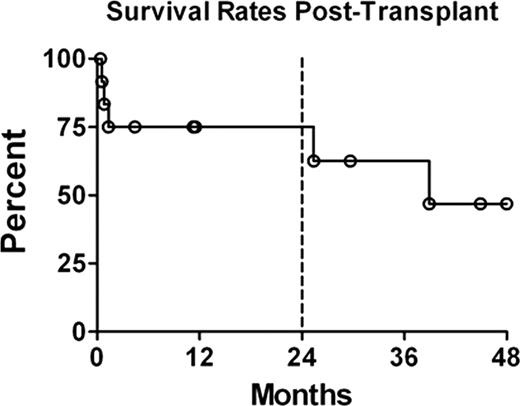Abstract
Abstract 4589
Burkitt lymphoma is a highly aggressive and rapidly proliferating hematologic malignancy. Various chemotherapy regimens (HyperCVAD, CODOX-M/IVAC, REPOCH) have been shown to improve overall survival rate. However, in instances of relapsed or refractory disease, there is no clear-cut standard of care. Hematopoietic stem cell transplantation (HCT) has shown benefit in these patients. Here, we report our institutional experience using HCT for relapsed/refractory Burkitt lymphoma.
Between February 1994 and January 2010, 13 patients (10 males, 3 females) with refractory or relapsed Burkitt lymphoma were retrospectively evaluated. The patients in question were administered a particular conditioning regimen followed by stem cell transplantation (11 autologous, 2 allogeneic). The average age at transplant was 41.8± 3.4 years (range 24 to 67). Stem cell source was from peripheral blood in all transplants including allogeneic (2 HLA-identical sibling transplants). The conditioning regimens for HCT consisted of the following: TBI/Rituximab/Cytoxan/VP16, TBI/Cytoxan/VP16, BEAM, Cranial Spinal boost/TBI/Cytoxan/VP16 or Cranial boost/TBI/Cytoxan.
On average, patients received transplant 299 ± 36 days after initial diagnosis (range 153 to 582). All patients achieved engraftment. For the 5/13 deceased patients (38%), cause of death was attributed to relapsed/refractory disease (n=2) and treatment related causes (n=3). Using the Kaplan-Meier method, the average survival time after transplant was computed at 27.7 ± 5.3 months and 75% were alive 2-years after transplant. Likely due in part to the small sample size, no covariates (age, gender, conditioning regimen, HIV status, presence of B symptoms, and CNS or bone marrow involvement) were found to be predictive of survival rates.
Patients with Burkitt lymphoma, known for its rapid growth, can achieve long-term complete remission (CR) with intense, combination chemotherapy. Despite successful long-term remission rates, a substantial portion of patients die from uncontrolled disease. At the first sign of refractory or relapsed disease, resources should be mobilized to proceed with HCT. Our study, though limited in size, provides further compelling evidence that long-term CR, and potentially cure, may be achieved using HCT as a treatment modality.
No relevant conflicts of interest to declare.
Author notes
Asterisk with author names denotes non-ASH members.


This feature is available to Subscribers Only
Sign In or Create an Account Close Modal